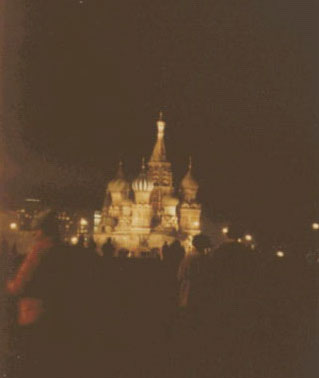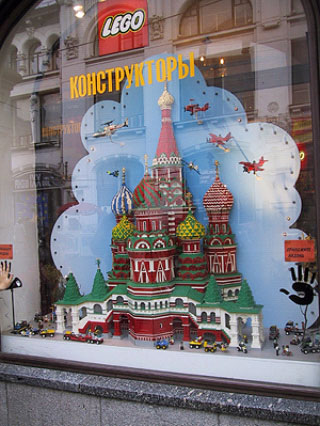Imaginary Homelands
Irina Sandomirskaja: Kniga o rodine. Opyt analiza diskursivnykh praktik [A Book About Home. Analysis of Discursive Practice]. Vienna 2001 (Wiener Slawistischer Almanach, Sonderband 50)
The changing face of Russian Rodina (meaning so much ore than just “motherland”) is maybe best exemplified by two photographs of Moscow’s landmark, St Basil’s Cathedral. The first was taken in 1978 during the period of stagnation, when rodina and its complementary terms otetchestvo (“fatherland”) and otchizna (“homeland”) had sunken to the status of clichés in the repressive discourse of the time.(Photograph by Mark Martin.)
Still, according to Baudrillard, the repressive discourse presupposes an authentic reality that lies, suppressed, beneath the surface and has to be unearthed. But this “authentic” reality, too, is shaped by the discourse around rodina, as it fulfils the desire (in the Lacanian sense) to compensate for the fundamental displacement of man in an otherwise meaningless world.
Therefore, the relationship between the official discourse around rodina and its reception by the Children of the Homeland may be descried as a kind of voluntary rape: rodina is forced upon those who accept it all to gladly.
The second photograph shows the same cathedral, but this time as a model constructed out of Lego bricks. The existence of this model is completely ephemeral: Lego bricks trade the essence of traditional building material for an indifferent artificiality that may be assembled and disassembled at will. In post-Soviet society, rodina no more coerces its children, but seduces the electorate. The mystical depth of an authentic reality that shone through the discourse has been replaced by sheer shiny surface, anticipating and fulfilling the consumer’s wish. Therefore, even the IKEA store in Moscow may be regarded as creating a new rodina for a certain target group.(Photo by Tetsuhiko Yoshimura.)
Still, the photographs are revealing. The picture of the real cathedral appears flat, its supposed depth is a mere trompe d’oeil. At the same time, the reflection as well as the words on the surface of the window pane add a third dimension to the Lego model, suggesting the need for a new center that manifests itself in the new national anthem or in recent legislation on patriotic education. For some strange reason, rodina remains a key concept of Russian culture.
It is this concept that Irina Sandomirskaja deconstructs in her Kniga o rodine. Opyt analiza diskursivnykh praktik (“Book about the motherland. An attempt to analyze discursive practices”), the most recent in a line of cultural self-descriptions edited in the Wiener Slawistischer Almanach series).
Rodina denotes a symbolic rather than a concrete space. It has no existence outside language and may therefore be analyzed as the result of linguistic strategies. Rodina is much like a linguistic idiom in that it does not easily lend itself to translation, since any translation fails to capture the connotations and the agglomeration of cultural meaning behind the word.(The reviewer had always thought that it was the signifier and not the signified which makes up the “untranslatability” of the idiom: He who, in Britain, is “raisins short of a fruitcake”, in Germany lack cups in the cupboard, but is crazy just the same.)
If rodina does not represent a reality, but presents it much in the way that an icon presents the spiritual world, it must suggest that there is an authentic source of meaning, and hence of stability, beyond the linguistic surface.
This stability, Sandomirskaja argues, is rooted in the very concept of language that was promoted in the early 19th century by the conservative statesman, admiral Aleksandr Shishkov, who insisted on the divine origin of the Slavonic (as opposed to all other) languages. Even if the discourse around rodina consists to most of hollow phrases, it is the result of a long and complex practice, the origin and manifestation of which are outlined in the book.
Part One consists of a chapter outlining the master plots shaping the narratives about rodina: the road that either leads back home or to an exile in which the wanderer has the choice between staying faithful to or betraying his rodina, but never to free himself from its shadow; the duty towards rodina to repay her loving care in peaceful construction or by defending her in war; the greatness of rodina, founded in its very vastness.
Unfortunately, it is not quite clear where Sandomirskaja derives these plots from (a body of texts is never proposed). Apparently, she relies heavily on her own experience as a Soviet Man – a suspicion that is heightened by the obvious contamination of her own discourse by the narratives in question.
The extremely intriguing chapter on “‘Naive’ writing and ‘naive’ rodina‘” traces the workings of these official “great” narratives on popular culture in a discussion of the memoirs of the pensioner Evgeniya Kiseleva, who interprets the events of her life – the war, the problems with her son-in-law – in the light of the officially disseminated master plots.
While Part One concentrates on the Soviet use of rodina, Part Two attempts an archeology of the layers beneath it. “Political formations come and go, rodina lingers on”, Sandomirskaja observes. It is the logic of the “broken telephone”, the (mis)quote of ideological fragments of the past, and the subsequent bricolage of a new ideological structure that accounted for the various reinterpretations of rodina.
The archeology of rodina consists mainly of a detailed study of the works of Admiral Aleksandr Semenovich Shishkov (1754-1841). Shishkov, author of Tsar Alexanders’s manifestoes throughout the Napoleonic War, head censor from 1826-1828, self-appointed lexicographer and poet, is portrayed as the founder of the imperial discourse of rodina that lasted till the fall of the Soviet Union.
From his four offices, Shishkov drew the linguistic strategies and subsequently the political influence to disseminate his ideas. Rodina, according to Shishkov, is incorporated mainly in the sacred Russian language, whose origin Shishkov traces all the way back to Japhet, Noah’s son.
Taken as a collection of essays (from which the book undoubtedly arose), Kniga o rodine contains some stimulating insights, passages of historical interest, or at least curiosity value (like the myths around the Soviet national anthem or Shishkov’s views on the hidden meaning behind the Russian vocabulary).
Reading it from cover to cover, one finds many loose ends. For example, the notions of rodina as idiom, as well as the “logic of the broken telephone” that makes up for the term’s varying connotations through the years, are developed theoretically at great lenngth, but never really put to use.
Also, an “archeology” that – albeit thoroughly – analyzes only two layers of the thick stratum of cultural meaning behind rodina, leaves room for more research. Sandomirskaja puts a lot of strain on a figure known to posterity mainly through Pushkin’s vicious epigrams. Pushkin’s own role, both actively and passively as “father of the Russian literary language”, would lead itself to a more thorough discussion, as would, indeed, other writers, all of which are just as deeply rooted in the tradition of the Enlightenment and European Romanticism as Shishkov.
A thorough archeology would also look at the native discourses of Russian national identity, which are almost as old as the first, Kievan empire, as well as the way Shishkov’s ideas were to bear on later generations.
Finally, I doubt Sandomirskaja’s assertion that rodina as a political term is the result of poetical practices, in that it is the result of linguistic imagination. Apart from the fact that the one isn’t necessarily equal to the other, this claim makes literature (the poetical discourse) responsible for shaping the political discourse of its time. And even if one was to deny the influence of politics on literature, it might be more appropriate to view both as functions of a common discursive formation.
As you can see, Kniga o rodine has the potential of generating further discussion, and maybe ArtMargins can provide a forum for this. Browsing its site, it is obvious that ArtMargins, too, is occupied with re-definitions of what Russia is about, playing on the game of “telephone” that transmits and changes cultural definitions. Some search deep space, some are more like Lego bricks, but all testify to Kniga o rodine as being an ochen’ svoevremennaya kniga.






